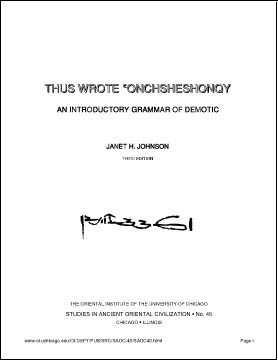SAOC 45. Thus Wrote 'Onchsheshonqy - An Introductory Grammar of Demotic Third Edition 2000 Janet H. Johnson

This highly acclaimed teaching grammar presents the fundamentals of the late stage of the ancient Egyptian language known as Demotic. A teaching grammar of Demotic has not been published before.
- Studies in Ancient Oriental Civilization 45
- Chicago: The Oriental Institute, 1991 (second edition revised), 2000 (third edition)
- ISBN: 0–918986–76–1
- Pp. vii + 126 (paperback, 8 x 10 inches)
Table of Contents
| LESSON | CONTENTS | PAGE | PARAGRAPH |
| Preface | Title Page, Table of Contents, Preface | i-vi | -- |
| Lesson 1 | Introduction, Alphabet, Sentence Types, Definitions | 1-8 | ¶¶1-11 |
| Lesson 2 | Nouns, Articles, Genitive, Independent Pronouns, Interrogative Pronouns, Nominal Sentences, Exercises | 9-18 | ¶¶12-25 |
| Lesson 3 | Sdm=f, Passive, Suffix Pronouns, Dependent Pronouns, Vocabulary, Exercises | 19-26 | ¶¶26-40 |
| Lesson 4 | Adverbs, Prepositions, Prepositional Phrases, Exercises | 27-34 | ¶¶41-44 |
| Lesson 5 | Infinitives, Qualitatives, Present Tense, Proclitic Pronouns, Future Tense, Vocabulary, Exercises | 35-42 | ¶¶45-53 |
| Lesson 6 | Adjectives, Sdm=f of Adjective Verbs, Demonstratives, Possessives, Exercises | 43-52 | ¶¶54-66 |
| Lesson 7 | Imperative, Optative, Questions, Proper Names, Numbers, Conjunctions and Interjections, Vocabulary, Exercises | 53-60 | ¶¶67-75 |
| Lesson 8 | Converters, Circumstantials, Relatives, Cleft Sentences, Vocabulary, Exercises | 61-72 | ¶¶76-94 |
| Lesson 9 | Second Tenses, Imperfect, Vocabulary, Exercises | 73-80 | ¶¶95-102 |
| Lesson 10 | Clause Conjugations, Terminative, Temporal, Conditional, Infinitive or Sdm=f as Object of a Verb, Finalis, Purpose Clauses, Conjunctive, Vocabulary, Exercises | 81-88 | ¶¶103-116 |
| Lesson 11 | Negatives, Present Tense, Other Main Clauses, Clause Conjugations, Historical Development, Exercises | 89-98 | ¶¶117-129 |
| Indexes | Demotic Index, Index to Passages Cited, English Index | 99-122 | -- |
| Bibliography | -- | 123-126 | -- |
Introduction to Demotic Grammar
Demotic is the name applied to both a script and a stage in the development of the Egyptian language. The stage of the language called Demotic shows affinities with both Late Egyptian, its predecessor, and Coptic, its successor. It was presumably much closer to the spoken language, especially when it first came into use, than was the archaic "classical" language preserved in religious texts and hieroglyphic inscriptions. The Demotic script is the most cursive one developed by the Egyptians. It was first used under Psammetichus I (ca. 650 b.c.), early in the Twenty-sixth, or Saite, Dynasty. By the end of that dynasty, Demotic had become the standard script for business and everyday affairs. By the Ptolemaic period Demotic was also the script in which literary compositions were written. The latest Demotic inscription, from Philae, dates from the middle of the fifth century of our era. During this 1,000-year time span Demotic was not a unity. There were differences, often minor but still evident, in script, vocabulary, morphology, and/or syntax between different geographical sections of the country, between different chronological periods (Demotic is usually subdivided into three time periods: early [Saite and Persian], Ptolemaic, and Roman), and between different types of texts. Among the latter are business and legal documents, private letters, religious, scientific, and medical and magical texts, mummy tags, funerary and administrative stelae (e.g., the so-called "trilingual" decrees), and literary texts, including both wisdom texts and stories. Even within these subdivisions, the script varies noticeably from scribe to scribe, as with modern handwriting.
The basic reference works are Demotische Grammatik, by Wilhelm Spiegelberg (1925), and Demotisches Glossar, by W. Erichsen (1954); a supplement to the latter will appear through the Oriental Institute, University of Chicago. These lessons are intended to give a person with some knowledge of Late Egyptian and Coptic an introduction to Demotic, including basic knowledge of Demotic grammar and an introduction to the script. They are based on the Ptolemaic period manuscript of the "Instructions of 'Onchsheshonqy" (P. British Museum 10508), published by S. R. K. Glanville (1955), because the script is fairly clear and legible and because the text involves both straight historical narrative passages and "literary" passages (i.e., the collection of aphorisms constituting the actual instructions). The grammatical summary presented here is limited to the basic elements. Minor details and exceptions are ignored. The student should consult Spiegelberg's Demotische Grammatik for such. Obviously the student must continue after this brief introduction to familiarize himself with the other handwritings and with other types of texts, especially the large corpus of legal texts.
The Demotic script is an abbreviated development of hieratic; like hieratic, it was written exclusively from right to left. The script in early Demotic texts can often be transcribed into the hieratic from which the Demotic developed. But by the Ptolemaic period the Demotic script was developing on its own, and the attempt to assign hieratic, and from the hieratic hieroglyphic, equivalents of words produces numerous artificial hieratic and hieroglyphic forms. Thus these lessons concentrate on the Demotic script itself, rather than on any real or hypothetical origin or contemporary hieroglyphic equivalent.
Demotic not only contained both phonetic signs and determinatives, but in addition many of the signs were ligatures of two or more such signs. Thus, even more than in earlier stages of the language, words were learned as units by the Egyptian scribe and must be so learned by the modern student. Every scribe had quite distinctive handwriting and there may be major differences between the ways two different scribes wrote the same sign. In these lessons the student will be exposed to just one system, that of the scribe of 'Onchsheshonqy, so that he can concentrate on grammar. After this, the major problem which remains in Demotic is to learn to read all the various scripts and handwritings. (from the Introduction, ¶¶1-4)

